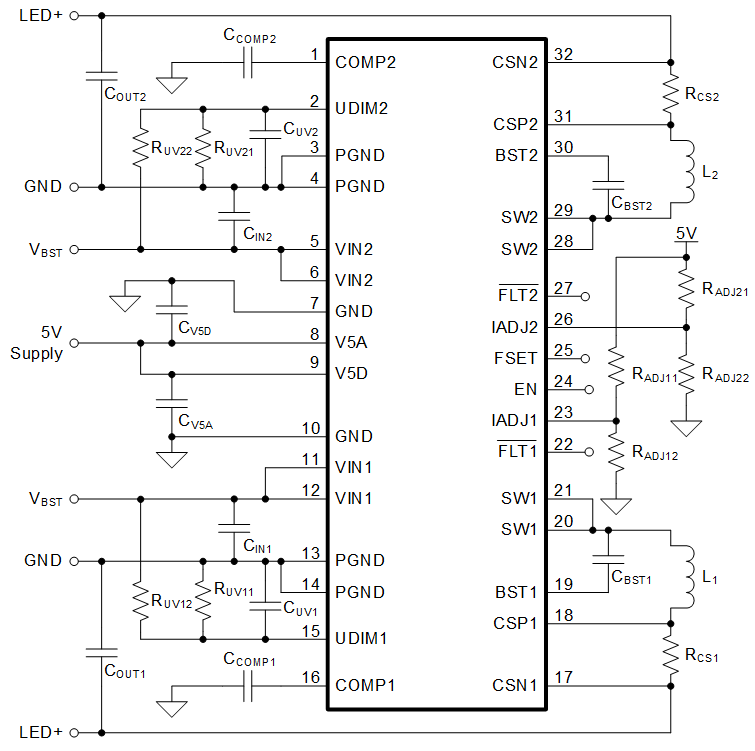ZHCSMX7A August 2021 – December 2021 TPS92519-Q1
PRODUCTION DATA
- 1 特性
- 2 应用
- 3 说明
- 4 Revision History
- 5 Pin Configuration and Functions
- 6 Specifications
-
7 Detailed Description
- 7.1 Overview
- 7.2 Functional Block Diagram
- 7.3
Feature Description
- 7.3.1 Buck Converter Switching Operation
- 7.3.2 Switching Frequency and Adaptive On-Time Control
- 7.3.3 Minimum On-Time, Off-Time, and Inductor Ripple
- 7.3.4 Enable
- 7.3.5 LED Current Regulation and Error Amplifier
- 7.3.6 Start-up Sequence
- 7.3.7 Analog Dimming and Forced Continuous Conduction Mode
- 7.3.8 External PWM Dimming and Input Undervoltage Lockout (UVLO)
- 7.3.9 Shunt FET Dimming or Matrix Beam Application
- 7.3.10 Bias Supply
- 7.3.11 Bootstrap Supply
- 7.3.12 Faults and Diagnostics
- 7.3.13 Output Short Circuit Fault
- 7.3.14 Output Open Circuit Fault
- 7.3.15 Parallel Operation
- 7.4 Device Functional Modes
-
8 Application and Implementation
- 8.1
Application Information
- 8.1.1 Duty Cycle Consideration
- 8.1.2 Switching Frequency Selection
- 8.1.3 LED Current Set Point
- 8.1.4 Inductor Selection
- 8.1.5 Output Capacitor Selection
- 8.1.6 Input Capacitor Selection
- 8.1.7 Bootstrap Capacitor Selection
- 8.1.8 Compensation Capacitor Selection
- 8.1.9 Input Undervoltage Protection
- 8.1.10 CSN Protection Diode
- 8.2
Typical Application
- 8.2.1 Design Requirements
- 8.2.2
Detailed Design Procedure
- 8.2.2.1 Calculating Duty Cycle
- 8.2.2.2 Calculating Minimum On-Time and Off-Time
- 8.2.2.3 Minimum Switching Frequency
- 8.2.2.4 LED Current Set Point
- 8.2.2.5 Inductor Selection
- 8.2.2.6 Output Capacitor Selection
- 8.2.2.7 Bootstrap Capacitor Selection
- 8.2.2.8 Compensation Capacitor Selection
- 8.2.2.9 PWM Dimming and Input Voltage Protection
- 8.2.3 Application Curves
- 8.1
Application Information
- 9 Power Supply Recommendations
- 10Layout
- 11Device and Documentation Support
- 12Mechanical, Packaging, and Orderable Information
3 说明
TPS92519-Q1 是一款单片双路同步降压 LED 驱动器,具有 4.5V 至 65V 宽工作输入电压范围,可独立为两串串联的 LED 供电。
TPS92519-Q1 实施自适应导通时间平均电流模式控制功能,经设计可与分流 FET 调光技术和基于 LED 矩阵管理器的动态光束前照灯兼容。自适应导通时间控制功能可提供近乎恒定的开关频率,可使用 FSET 输入来设置该开关频率。电感器电流感应和闭环反馈功能可在较宽的输入电压、输出电压和环境温度范围内实现 ±4% 以上的精度。
高性能 LED 驱动器可使用模拟调光或 PWM 调光技术来单独调制 LED 电流。通过在高阻抗模拟调整 (IADJ) 输入范围内将电压从 140mV 改变为 2.45V,可获得超过 16:1 范围的线性模拟调光响应。通过使用所需占空比和频率直接调制对应的 UDIM 输入引脚,实现 LED 电流的 PWM 调光。该器件支持高频分流 FET 调光,并与使用 LED 矩阵管理器的像素控制技术兼容。
TPS92519-Q1 支持两个或更多通道的并行运行,从而实现驱动大电流 LED 或激光二极管所需的灵活性。电流基于 IADJ 输入在并行通道之间共享,不受元件容差和寄生效应的影响。
TPS92519-Q1 包含高级故障保护功能:逐周期开关电流限制、自举欠压和热关断。该器件包括一个开漏故障输出以指示输出开路和短路情况。
TPS92519-Q1 采用 8.1mm × 11mm 热增强型 32 引脚 HTSSOP 封装,具有 2.75mm × 3.45mm 的底部外露焊盘。
| 器件型号(1) | 封装 | 封装尺寸(标称值) |
|---|---|---|
| TPS92519-Q1 | HTSSOP | 8.1mm × 11mm |
 简化版原理图
简化版原理图